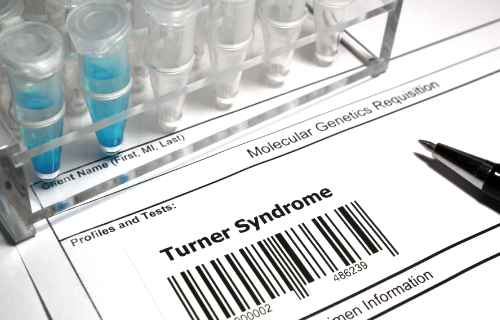
Down and Turner syndromes are both chromosomal abnormalities but differ in terms of which chromosomes are involved as well as their prevalence, causes, characteristics, diagnosis, and prognosis.

Prevalence
Down syndrome (DS), first described by John Langdon Down, an English physician in the late nineteenth century, is the result of a full or partial copy of chromosome 21 with which 1 in 700 babies in the United States are born (National Down Syndrome Society). In contrast, Turner syndrome (TS) occurs exclusively in females with just one instead of two X chromosomes. About 1‒2% of embryos have TS, but 99% of these embryos will spontaneously abort, most often during the first trimester, leading to about 1 in 2500 live births worldwide (US Department of Health and Human Services).
Causes
The cause of the extra partial or full chromosome in DS remains unknown, but maternal age has been identified as a factor. For example, a 20-year-old mother has a 0.1% chance of giving birth to an infant with DS while a 45-year-old mother has a 3% chance (J. K. Morris et al.). In about 5% of cases the origin can be linked to the father.
Several types of DS have been identified.
- Trisomy 21 occurs when before or during conception, a pair of chromosomes 21 in the sperm or ovum do not separate, resulting in three copies of chromosome 21, rather than two. These replicate in every cell of the body.
- Translocation DS is evident in about 4% of cases. Here the number of chromosomes is 46, but a full or partial copy of chromosome 21 is attached to another chromosome, most often chromosome 14. A hereditary component been identified in about one-third of these cases.
- Mosaic DS, which occurs in about 1% of cases of DS, is the result of some cells containing 46 chromosomes and others 47.
TS is a genetic disorder affecting only females. It results from a missing or partially missing X chromosome from most or all cells. Females with TS do not mature sexually.
Characteristics
Physically, DS is characterized by low muscle tone, a slightly flattened facial profile, an upward slant to the eyes, small stature, and single deep creases across the palms’ center. The condition is associated with physical growth delays and mild to moderate intellectual disability, with the average IQ of a young adult being the equivalent of an eight or nine-year-old (André Mégarbané et al. 2013).
TS is characterized by a webbed neck, broad chest, short stature, small chin, abnormal forearm angles, short fingers and failure to mature sexually (Benjamin Saddock and Saddock; C. S. Oliveira and Alves).
Diagnosis
Prenatally, DS can be diagnosed through blood serum tests and a sonogram to check for markers. More invasive and accurate diagnostic tests include chronic villus sampling, conducted in the first trimester, and amniocentesis, conducted in the second trimester. Both diagnostic tests include a 1% risk of a spontaneous abortion, but both are nearly 100% diagnostically accurate. When screening indicates the presence of DS, the embryo is often aborted (J. L. Natroli et al.). At birth, DS is identified through presence of the physical traits and drawing blood from the infant for genetic tests to confirm the diagnosis.
Diagnosis of TS may occur at birth using physical characteristics and drawing blood from the infant for genetic testing. Because most people with TS have normal intelligence, the condition may only be diagnosed at adolescence with the failure of the onset of menses; however, spatial visualization problems have been noted to be above the norm (V.P. Sybert).
Prognosis
Because DS and TS are genetic conditions, there is no cure for either condition. Most people with DS require educational support and a sheltered work environment, and in the developed world, their life expectancy would be between 50 and 60 years. With respect to TS, while girls can enjoy a normal life with hormone treatments that help with the development of hips and breasts, they cannot fall pregnant naturally.
Table showing the differences between Down and Turner syndromes

Summary
Turner and Down syndromes are caused by different chromosomal abnormalities. DS is the result of an extra full or partial chromosome 21, while TS is the result of a missing or altered X chromosome. Both sexes can be affected by DS, but only females can be affected by TS, which might only be diagnosed at adolescence. Both produce distinct physical features, and while DS is associated with a mild to moderate mental disability, TS is associated with infertility.
FAQ
Is Turner syndrome and Down syndrome same?
Turner and Down syndromes are among the most common chromosomal abnormalities dealt with by physicians but are caused by different chromosomal abnormalities. In TS, the female infant is missing an X chromosome, and in DS, an infant of either sex has an extra full or partial chromosome 21. While DS is most often diagnosed at birth, Turner syndrome may not be diagnosed until adolescence.
What is the difference between Down syndrome and Down’s syndrome?
Down syndrome and Down’s syndrome are synonyms, but the preference is Down syndrome because using the apostrophe implies ownership or possession (National Down Syndrome Society).
What is Down and Turner syndrome?
Both Down and Turner syndromes are chromosomal abnormalities, but while DS is the result of an extra partial or full chromosome 21, TS is the product of a missing or altered X chromosome in all or some cells.
How is Down’s syndrome different from Klinefelter’s and Turner’s syndrome?
Down syndrome involves an extra full or partial copy of chromosome 21. Turner syndrome affects only females and involves a missing or altered X chromosome in all or some cells. Klinefelter syndrome affects only males and involves an embryo receiving an extra X chromosome in addition to a Y chromosome (Benjamin Saddock and Saddock).
- Difference Between Ecchymosis and Erythema - August 15, 2022
- Difference Between Autobiographical Memory and Episodic Memory - August 1, 2022
- Difference Between Biological Drive and Social Motive - July 30, 2022

